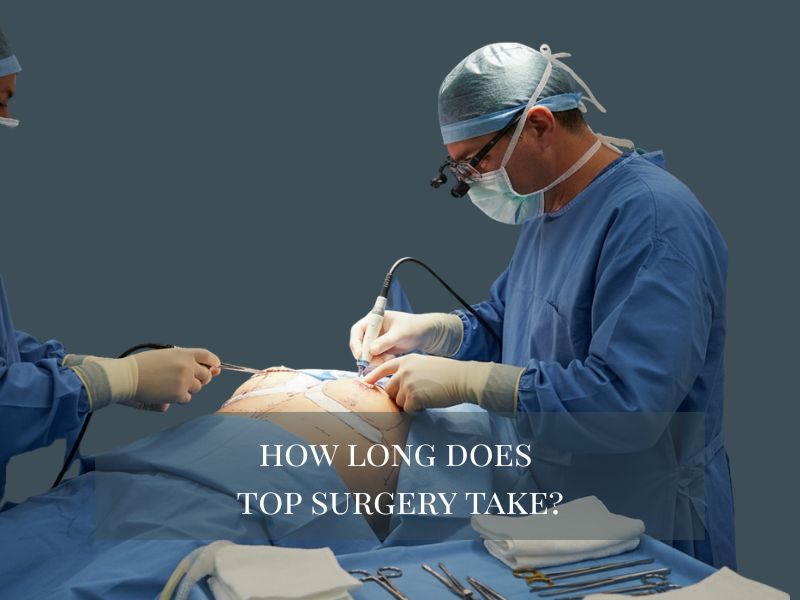Gender affirming surgery is a deeply personal and life-changing experience for many transgender and non-binary individuals. One of the most common questions patients ask during their consultation is: How long does top surgery take?
Top surgery in Atlanta typically takes between 2 to 4 hours, depending on the technique, the patient’s anatomy, and the surgeon’s approach. However, the timeline also includes preparation, recovery, and emotional readiness, which are equally important in achieving successful results.
Table of Contents
ToggleUnderstanding Gender Affirming Surgery
Gender affirming surgery, including top surgery, is a procedure that alters the chest’s physical characteristics to align with a patient’s gender identity.
This surgery that alters characteristics of the chest can involve removing breast tissue, contouring the chest wall, and, if necessary, nipple resizing or repositioning for a natural appearance.
Skilled and compassionate breast surgeons, such as board-certified plastic and reconstructive surgeons, perform top surgery to help patients achieve comfort in their bodies and improve emotional well-being. For many, it is a key step in treating gender dysphoria and enhancing quality of life.
The goal of top surgery is not just aesthetic; it’s to support physical, emotional, and psychological health through a patient’s personalized treatment plan created by the care team.
Determining Candidacy
Not every person is immediately ready to undergo top surgery. Becoming a candidate for top surgery involves several important steps and evaluations.
Medical and Psychological Readiness
Before scheduling your procedure, your physicians and health specialists will perform a thorough evaluation and physical exam. This assessment ensures you are both physically and emotionally ready for surgery.
You’ll have the opportunity to discuss your goals, expectations, and overall health history with your care team.
In addition, medical and psychological evaluations are conducted to confirm your emotional readiness for surgery.
Some practices may also require a written letter from a licensed mental health professional stating your readiness and understanding of the procedure.
Managing Complicating Conditions
Patients with potentially complicating medical conditions, such as uncontrolled diabetes, heart issues, or smoking habits, must be cleared by their primary care physician. Your primary care physicians understand the complexities of top surgery and will ensure you’re medically prepared before proceeding.
A Personalized Treatment Plan
Your plastic surgeon and care team will design a personalized treatment plan based on your anatomy, skin elasticity, and aesthetic goals. This plan covers pre-operative instructions, the type of anesthesia, and recovery expectations.
Types of Top Surgery Procedures

There are different top surgery procedures, each suited to the patient’s body type, goals, and skin characteristics. Plastic and reconstructive surgeons will explain the options during your consultation.
1. Double Incision Top Surgery
The double incision top surgery technique is the most common for those with medium to large chest sizes.
- The surgeon removes breast tissue and excess skin.
- Nipples may be resized or repositioned for a masculine contour.
- Small drains may be placed to prevent fluid buildup.
This type of gender confirmation surgery often provides dramatic results and a flatter, more sculpted chest.
2. Periareolar or Keyhole Top Surgery
For patients with smaller chests and good skin elasticity, the periareolar or keyhole method may be ideal.
- These techniques involve minimal scarring and shorter recovery times.
- The surgeon makes smaller incisions around the areola and uses unique surgical techniques to remove tissue.
3. Liposuction-Assisted Top Surgery
In some cases, liposuction may be used to fine-tune contouring or reduce remaining fat tissue. It’s often combined with other methods for optimal results.
Preparing for Top Surgery
Preparation is a key step in ensuring a safe and smooth experience. Patients are encouraged to take time to prepare both physically and emotionally.
Medical Preparation
- Complete all pre-operative lab tests and in-person consultation appointments.
- Discuss all medications with your surgeon, some may need to be stopped temporarily.
- Avoid nicotine and alcohol for several weeks before surgery to support healing.
- Your care team may also instruct you to arrange transportation and a support person for your overnight stay if required.
How Long Does Top Surgery Take?

Most top surgery procedures last between 2 and 4 hours, though the entire top surgery timeline, from anesthesia to recovery, can take most of the day.
- Regional anesthesia or numbing medicine is often used, providing significant pain relief during and after surgery.
- Some patients may receive general anesthesia, depending on their treatment plan and preferences.
Numbing medicine provides significant pain relief that allows patients to remain comfortable during the operation.
What Happens During Surgery
Your board-certified plastic surgeon begins by marking the chest to outline incision lines and nipple placement.
The surgery procedure typically includes:
- Removing breast tissue and excess skin.
- Contouring the chest wall for a masculine or flat appearance.
- Nipple resizing or repositioning, if necessary.
- Closing incisions and applying dressings or compression wraps.
Sometimes an ace wrap is wrapped around the chest immediately after surgery to minimize swelling.
The procedure may also involve regional anesthesia numbing medicine, depending on your personalized treatment plan and comfort level.
Top Surgery Recovery and Aftercare
Recovery varies depending on the type of top surgery procedure, but most patients need at least 2 to 3 weeks before returning to normal activities.
Here’s what you can expect from top surgery recovery:
- First 48 Hours: You’ll experience swelling, mild discomfort, and limited arm movement. Pain medication prescribed by your surgeon will help manage symptoms.
- Week 1–2: Drains (if placed) are usually removed, and swelling starts to decrease. You’ll wear a surgical bra or compression garment to support healing.
- Week 3–6: Most patients gradually resume light activities and may return to work depending on their recovery progress.
- Months 2–3: Incisions continue to heal and scars begin to fade. Exercise can be resumed once cleared by your surgeon.
Aftercare Tips
- Keep the surgical site clean and dry.
- Avoid lifting heavy objects until cleared by your care team.
- Wear compression garments as directed to reduce swelling.
- Attend all follow-up appointments to monitor healing.
- Reach out to your care team immediately if you notice signs of infection or unusual swelling.
Choosing a Qualified Surgeon
When considering top surgery, choosing the right surgeon is one of the most important decisions you’ll make.
Look for a board-certified plastic and reconstructive surgeon who is specially trained and committed to gender affirming care. The right specialist will perform a thorough evaluation, physical exam and personalized treatment plan to ensure your surgery meets your goals safely.
Your surgeon should specialize in gender affirming surgery and have performed multiple FTM top surgery procedures.
They should also have experience with the complexities of top surgery and use unique surgical techniques to create natural-looking results.
Finally, make sure your surgeon works alongside a compassionate team of primary care and behavioral health specialists who can support your journey every step of the way.
We support your affirmation goals
The decision to undergo top surgery takes thoughtful consideration. A compassionate team of primary and specialty care physicians trained in LGBTQIA+ care can help you determine whether top surgery is right for you. Dr. CV Chegireddy’s team at Aesthera Plastic Surgery offers a full scope of affirming services, guiding each patient with sensitivity, expertise, and personalized attention from consultation to recovery.
Conclusion and Next Steps
Top surgery is a transformative procedure that helps align your physical appearance with your gender identity.
Understanding how long top surgery takes, what the procedure involves, and how to prepare can help you approach your journey with confidence.
If you’re considering top surgery, the next step is scheduling an in-person consultation with a board-certified plastic surgeon who specializes in gender affirming procedures.
Your care team will provide a personalized treatment plan that supports your physical and emotional health at every stage from consultation to full recovery.
Top Surgery Timeline FAQs
Does insurance cover top surgery?
Insurance coverage for top surgery varies widely by provider and plan. Most insurers require prior authorization proving medical necessity for gender dysphoria, following WPATH guidelines. Documentation includes support letters from healthcare providers and mental health professionals. Even with approval, patients face deductibles, copays, and out-of-pocket expenses. State laws influence coverage requirements
How much is top surgery?
FTM top surgery costs $8,000-$16,000 on average, with cash-pay rates reaching $14,000-$17,000. Double incision is the most common method for removing breast tissue. Total expenses include surgeon fees, facility costs, anesthesia, and follow-up care. With insurance coverage, out-of-pocket expenses drop significantly but vary by plan and deductible.
How long does top surgery take from start to finish?
The surgical procedure itself usually lasts 2 to 4 hours, depending on your anatomy and chosen technique. Including preparation and recovery, expect to spend most of the day at the surgical center.
What is recovery like after top surgery?
Top surgery recovery takes several weeks. You’ll need rest, a surgical bra or compression garment, and follow-up care. Most patients return to normal activities within 4–6 weeks, though full healing may take several months.
Do I need a letter for top surgery?
Yes, most surgeons require a written letter from a mental health provider confirming physical and emotional readiness for surgery. This ensures your decision is supported and you meet eligibility requirements.
Will I feel pain during or after top surgery?
During surgery, regional anesthesia numbing medicine provides significant pain relief. Afterward, pain medication will help manage discomfort during the initial recovery phase.
How do I know if I’m a good candidate for top surgery?
You must undergo a thorough evaluation and physical exam. Patients should be in good health, have emotional readiness, and be cleared of any potentially complicating medical conditions before surgery.
Ready for Your FTM Top Surgery Consultation?
Take the next step toward your goals with Dr. CV Chegireddy at Aesthera Plastic Surgery. Schedule your consultation today to discuss your options, review your plastic surgery cost, and create a physical and emotional plan that supports your journey.
Dr. Chegireddy and his highly skilled and compassionate team of plastic and reconstructive surgeons will guide you through every step, ensuring the most appropriate course of treatment for your needs. Their clinicians are specially trained to provide expert care for patients seeking gender affirming surgery.
You’ll receive support from health specialists and primary care providers who understand the importance of safety, comfort, and individualized care within a complete scope of affirming services.



